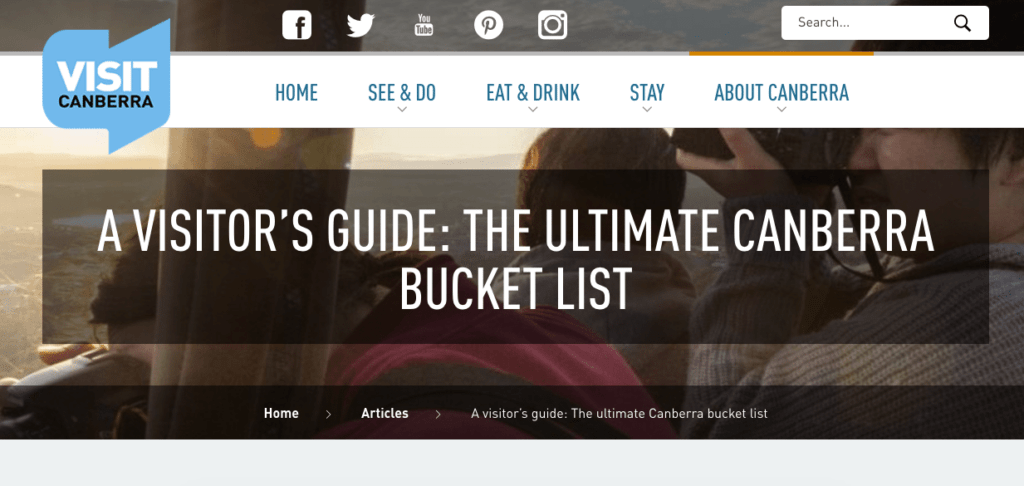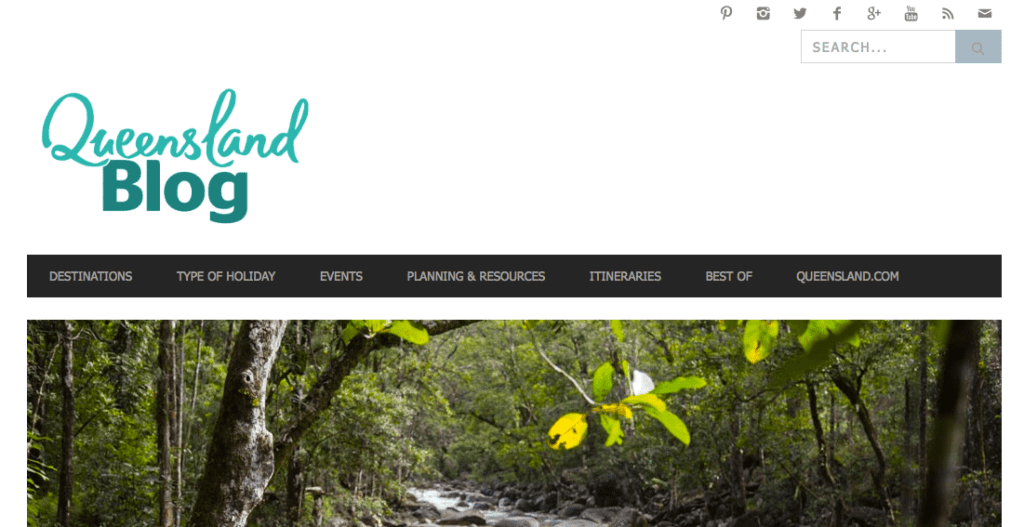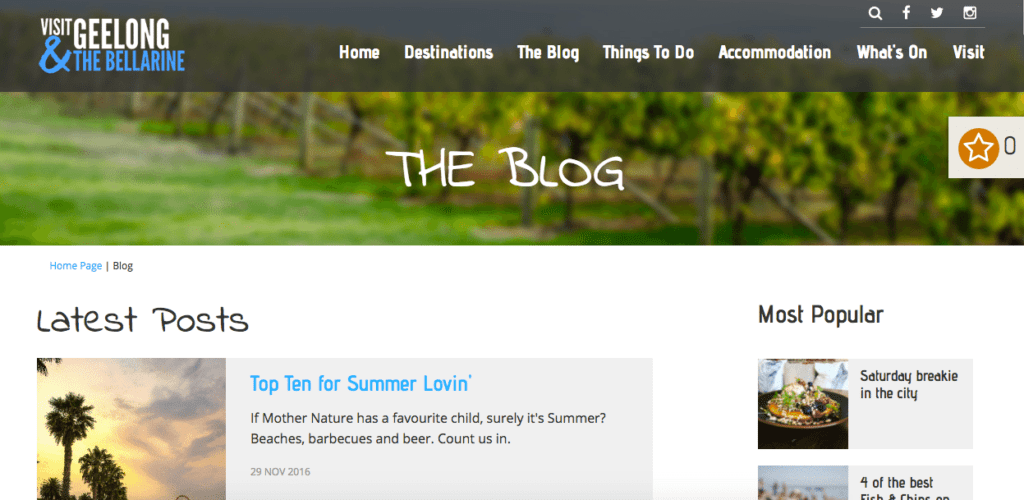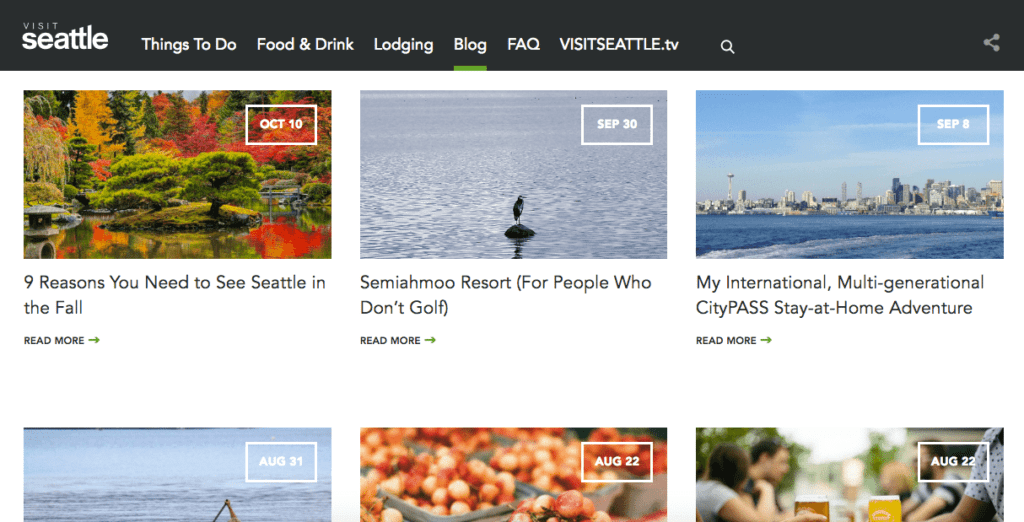Storytelling is at the very heart of destination marketing. Understanding your destination’s story is one thing, but communicating it is another. You can communicate it through branding and campaigns, but, what people will really engage with are the ‘real’ stories of your destination, the ‘actual’ experiences they can have when they are there.
Creating exceptional content is key to Destination marketing
The creation of exceptional content is what engages people, and influences them in the consideration phase of their buying funnel. According to ZMOT, people reference 10.4 sources of information prior to making a purchasing decision, and the sources they are referring to include blogs, reviews and customer comments.
So, in order for destinations to leverage this opportunity, they need to focus energies into word of mouth marketing tactics, and also the creation and publishing of unique, engaging and relevant content on a blog.
Why all Destinations should be Blogging
Blogging is a smarter way to invest your marketing budget
So many destinations are spending loads of budget on social media strategy and implementation to engage potential visitors – which is investing resources in platforms which they don’t own.
Now, I’m definitely not saying that social media is a waste of time – it offers a fantastic opportunity to engage, but, content shouldn’t be created exclusively for social media, as the lifespan of SM content is so short.
Blog content is evergreen – which means that it will always be available to access, and can be reshared over and again, giving it an endless lifespan. So therefore, all content should be created and published on your blog, and then shared out onto social media platforms. That way, you are still sharing your brilliant content, but you are encouraging visitation to your website to access the content, and giving your destination more opportunity to be considered as a holiday option by potential visitors.
Blogging helps build a dynamic online presence for your Destination
The majority of Australian destination websites are two-dimensional. They feature regional information, events, search and booking functionality and never-ending lists of tourism product. Some feature an itinerary builder, or wish list functionality, which offers a little bit of interaction (but from my experience they don’t result in increased conversions), but none of these things are geared toward building a sense of place, or a desire to visit.
Blogs are a powerful vehicle in which destinations can tell their stories and build relationships with potential visitors, giving them a taste of the real experiences they could have whilst in region, rather than just ‘what to do’.
People can engage with blog posts. They can share blog posts with their friends and family on social media, and they can comment on the posts and engage with real people who live and breadth the destination – a strong selling point.
This engagement helps destination website’s to become a more holistic information source for potential visitors, and also will also assist with the conversion of more visitors for the destination.
Blogging encourages more visitation to your Destination’s website
Blogging is the foundation tactic for your search engine optimisation strategy. With content at the very heart of SEO, search engines are constantly looking for relevant, inspiring and popular (authoritative) content to fill their search engine results pages.
Each blog post has the ability to target specific, and relevant search terms, which gives your website breadth when it comes to being found in search engine results, therefore, attracting people looking for all types of holiday experiences, not just those searching for the name of your destination.
So, if you are creating wonderful stories, sharing them via social media, and receiving great traction and engagement (on social and on your blog), the post is building its authority as a relevant source for the search terms that it has been optimised for, and therefore will be rewarded in search engine results.
From there, your authoritative posts will receive an increase in qualified visitors to your website, which gives you the opportunity to convert move website visitors, into actual visitors to your destination.
IMPORTANT NOTE.
When setting up a blog you should always integrate it into your main website by hosting it in a subfolder of your main domain e.g. ‘www.destination.com/blog’ rather than as a subdomain e.g. ‘blog.destination.com’ or as a separate domain e.g. ‘www.destinationblog.com’.
As a subfolder of your main site, search engines will see your blog and main website as one website, which means that your blog posts will have a higher propensity to rank well because of the authority of your destination website. Also, any inbound links or social activity on your blog posts will offer a benefit to your website as they are pointing to your main domain.
How to Create your Blogging Strategy
Before you start your blog, it is important to have a clear idea about what the purpose of the blog is, and how it will be managed. A blogging strategy is simply a set of steps that you will take to ensure the blog is consistent, on-brand, engaging and relevant.
Set Objectives
Like any marketing tactic, it is important that you have a clear idea about what you want your blog to achieve. How will your blog, and all of its opportunities help to achieve your overall marketing goals?
A blog has the power to convince potential visitors to purchase (accommodation, tours, attraction tickets etc), and it also is a great vehicle to encourage people to sign up to your destination’s email updates – giving you more opportunity to engage with your visitors in their inbox on a regular basis.
Editorial Calendar
The second step in your strategy is to develop an editorial calendar. This will act as a guide for storylines, and ensure you cover all of the main topics and experiences in the region. You will no doubt have an abundance of potential storylines, but try to think a little outside of the square, delve deep into what makes your region tick, and what stories are going to make people want to visit!
Resourcing
I know resources are tight in tourism organisations, and yes, writing blog posts does take time, energy and skill. But, there are a few resourcing tactics you could consider when devising your blog strategy.
Create the content inhouse
The first and most obvious option when it comes to resourcing your blog is to create the content in-house. Referencing your Editorial Calendar, you could create posts using the following content collation ideas:
- Interview a regional character or business – Great if you are a membership base organisation, as it could form part of your member benefits
- Build an itinerary for a customer segment – What can a family of 2 adults and 2 children do in your destination for 1 day/3 days
Curate content from external contributors
User generated content is a key marketing tactic that destinations are using on social media, and is definitely replicable in blogging. To help resource your blog, you could invite the following people to contribute to your blog:
- Professional travel bloggers to guest blog – They will love this opportunity, as it will help them with their website SEO and also gain visitors to their travel blog too)
- Professional photographers – photos are great content for blogs, so you could hire a photographer for a day to undertake experiences in region, and then post the images + captions in a blog article
- Regional Experts / Characters – There are so many advocates in tourism who have great writing skills which I’m sure you could approach to see if they would like to blog on a regular basis.
- Visitors – Collating visitor comments and photographs is great content for a blog – but make sure you get their permission first!
Share your blog
There is no point creating all of this exceptional content and publishing it on a blog if you don’t share it far and wide! So, in your blogging strategy, you will need to identify how you will syndicate the content that you have created to ensure maximum exposure.
So, once you have published your posts, then you could:
- Share them on your social media accounts
- reference them in your enewsletter to visitors, and industry enewsletters
- Share them on public relation websites such as prwire.com.au
- Approach relevant travel magazines to see if they will publish the post in an upcoming printed edition, or on their blog.
- Encourage your industry operators to share the content in their social media accounts, and emarketing channels.
Our Favourite Destination Blogs…
Every year I go on a hunt for fantastic tourism destination blogs, and in 2016, I’ve come up with this list!
Travel Oregon
Queensland
Geelong + The Bellarine
Seattle
Canberra

Do you know of a fantastic Destination Blog?
If so, then we’d love you to share your blog URL in the comments below!



